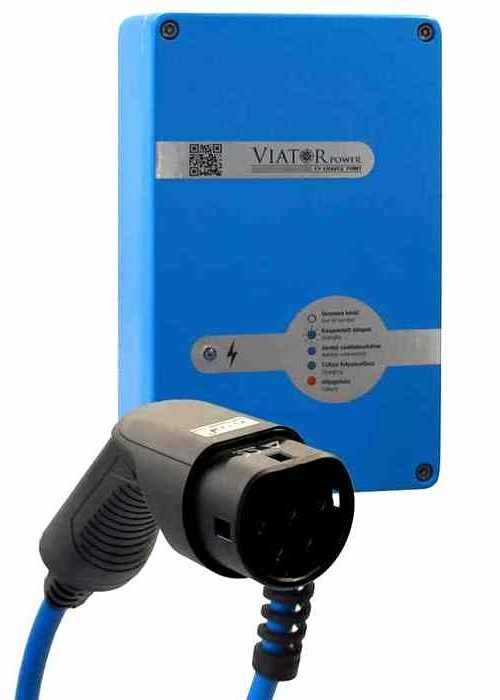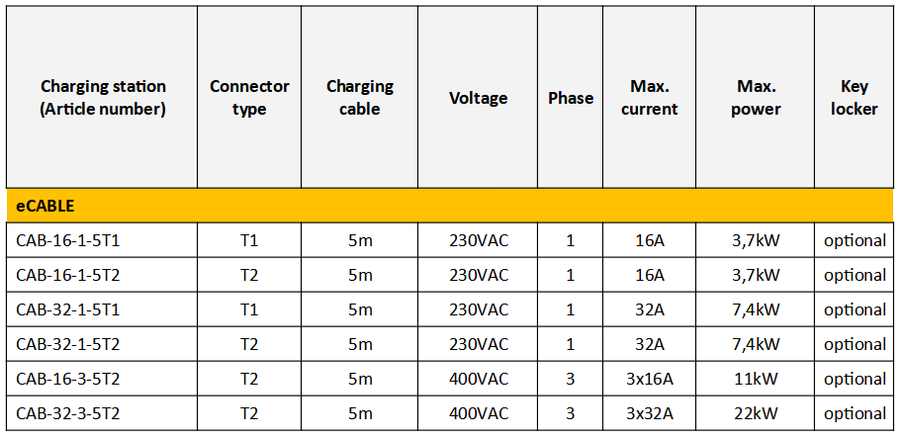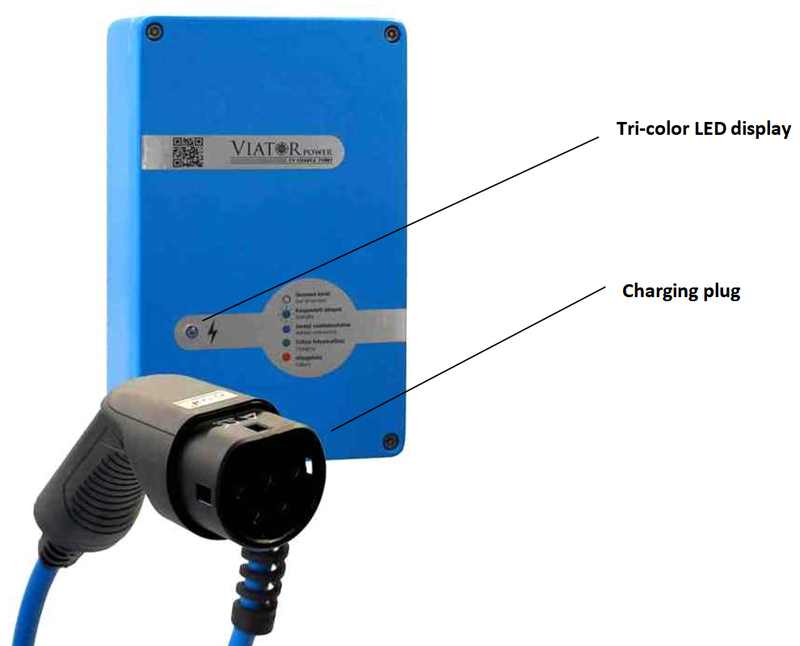Home » Használati útmutatók » ViatorPower eCABLE user manual – EN

CAB-32-1-5T1, CAB-32-1-5T2, CAB-16-3-5T2, CAB-32-3-5T2.
ViatorPower eCABLE
USER MANUAL
EV Charging Station with built-in charging cable
e-mail: info@encase.hu , www.viatorpower.com
Tel.: +36 30 952 4003
Manufacturer and distributor: ENCASE Ltd., Hungary
Please read this user manual through carefully, before using the EV Charging Station for the first time!
Thank you for purchasing our product!
Viatorpower eCABLE charging station is an EVSE (Electric Vehicle Supply Equipment) to charge the batteries of full electric and plug-in-hybrid cars. eCABLE has its own integrated charging cable, which is built into the device, and at its other end there is a Type1 or Type2 plug, depending on type of your car’s charging inlet.
eCABLE charging station is the ideal solution if you want to charge your electric car quickly and conveniently.
The device can be mounted onto the wall or to an optionally available EVSE pillar unit, preferably where your vehicle is usually parked – such as in a garage, parking lot, parking space – both indoors and outdoors.
Please note that the installation of the appliance may only be carried out by a qualified electrician!
We hope that the device will help you in long run to enjoy the pleasure of electric driving and always have enough energy at your disposal to reach your destination safely.
For more useful information on charging electric vehicles, please visit www.viatorpower.com. If you still have questions about the use and operation of the device, please contact the manufacturer’s customer service at info@viatorpower.com, where they will be happy to answer your questions.
Quality guarantee: 2 years warranty
The device has been designed and manufactured to serve you without failure for long time. If, within two years of purchase, it still fails and the defect is attributed to the defective design or manufacture, it will be repaired or replaced at the manufacturer’s own expense.
To use the warranty, you need the warranty card and / or a copy of the invoice. For details please refer to the information on the warranty card or contact the distributor.
1. Safety instructions
1.1. Notices
Observe the notices in the installation guide and the relevant legal regulations.
Mounting and installation specifications may differ depending on the installation location. It is the responsibility of the installer to comply with safety regulations, standards, professional protocols and applicable legislation.

ATTENTION! RISK OF ELECTRIC SHOCK!
Touching live parts can result in accidents, life-threatening, and serious property damage. Always de-energize the appliance and the network before installation and pay special attention to comply with the electric shock protection and safety regulations.
The appliance must be placed in a location that is not reachable by children!
Do not install or use the device in the presence of flammable and explosive gases!
THE APPLIANCE MUST BE INSTALLED BY A QUALIFIED ELECTRICIAN!
The device can only be used when it is permanently connected to the electric network. It is forbidden to operate from a socket or outlet!
Use the device only for its intended purpose as described in the operating instructions!
WARNING! ALL RESPONSIBILITIES AND OBLIGATIONS OF THE MANUFACTURER AND DISTRIBUTOR CEASED IF THE APPLIANCE IS NOT USED FOR ITS PURPOSE.
1.2. Fuses and cables
When installing the device, always use switching devices in accordance with the specifications and apply the appropriate cables and wires according to the nominal voltage and current!
1.3. Repairs
The end-user must not carry out any repairs on the device!
Opening or removing the cover of the device by the end-user is life-threatening and prohibited!
Do not modify the device in any way!
WARNING! ALL RESPONSIBILITIES AND OBLIGATIONS OF THE MANUFACTURER AND DISTRIBUTOR CEASED WITH ANY MODIFICATION / CHANGE OF THE APPLIANCE BY THE END USER.
1.4. Recycling
The device must be disposed of as hazardous waste at the end of its life cycle and / or as non-repairable device and must be disposed at an electronic recycle point.
2. General description
eCABLE charger is used to charge batteries of full electric and plug-in hybrid cars (EVSE – Electric Vehicle Supply Equipment).
The eCABLE has its own charging cable, which is integrated into the charger. At the other end of the charging cable (which is connected to the vehicle) is a Type1 or Type2 plug installed, depending on type of your car’s charging inlet. You do not need a separate charging cable for charging, just use the built-in cable.
Electric vehicle’s original accessories are usually including a 230 V outlet chargers. These usually charge the vehicle from a household socket for a very long time because their charging power is limited (usually not exceed 2… 2.5 kW – 10… 12 A charging current). The eCABLE is significantly more powerful, so it can be used to charge electric vehocle much faster than with the low power household-socket charger.
The device is available in six versions, which are capable of delivering different power and are equipped with different connectors.


Which type of charger shall be used for your car depends on two important factors:
1. What is the max. power (max. charging current) the vehicle’s on-board charger can accept
2. The max. load of local grid at the installation site
During the process of charging electric vehicles, data is exchanged and communication is going on between the charging point and the on-board charger that is built into the vehicle. This data exchange covers (among other things) the maximum charging current that the charging station can deliver and the current that the vehicle’s on-board charger able to accept and handle. Therefore, for example, it is not possible to charge a car with 11kW power in case its on-board charger can handle only max. 6kW charging power.
Some vehicles can be charged with a three-phases, others with only a single-phase current. If the performance of the external charging point differs from the performance of the car’s on-board charger, that’s not a problem, but charging will always be at the lower of these two. So the maximum charging current (maximum power) only indicates the maximum power that the charger is capable to deliver. However, whether you can take full advantage of the maximum charging power depends on the specifications of the vehicle’s on-board charger.
It has to be considered that an electrical network of a property is a complex system. The wires, the electrical utility connections are sized for the general needs of the household and there may not be enough reserve in the system to connect an additional high-power consumer such as an EV charger to the grid. It may not be possible to use certain electrical consumers during charging process because of overload in the network.
Poorly sized wires can become hot and, in extreme cases, ignite, causing serious property damage and death. Therefore, be sure to have the property’s electrical system inspected by a professional electrician before installing the EV charger. It may also be necessary to request the electricity supplier to increase the electrical capacity of the property. (To use eCABLE devices, 7.4kW (1x32A), 11kW (3x16A), or 22kW (3x32A) electrical power shall be available in the electrical network of the property.)
Techincal specifications
- Nominal voltage: 230V AC (1 phase), or 400V AC (3 phases).
- Maximum charging current: 16A or 32A.*
- Max. charging power: 7,4kW, 11kW, 22kW.*
- Overcurrent- and electric shock protection: Not built-in, must be installed at the installation site separately.
- Charging cable: Fixed built-in.
- Plug type: Type1 or Type2.*
- Display: Tri-color LED
- Housing: Flame and impact resistant, fiberglass reinforced, extruded polyester, painted.
- IP protection: IP 54.
- Operational temperature: -20…+50ºC.
- Enclosing dimensions: 160 x 260 x 150 mm.
- Weight: cca.7,0 kg.
* Depending on the appliance type.
THE APPLIANCE SHOULD ONLY BE INSTALLED BY A QUALIFIED ELECTRICIAN!
In accordance with the relevant standards, electrical safety devices (RCO, RCB) have to be installed in the charging circuit during installation. These devices are not included with the charger and must be purchased separately. The distributor offers them in optional installation kits which can be ordered from the distributor.
3. Using the device
3.1. Introducing the device
The LED indicator shows the status of the device and the charging process. The LED is located inside the device, its light is clearly visible from a distance through a small window mounted on the front panel.
When the device is powered, the control electronics runs initialization and self-test program. This takes about 5…10 seconds and during this initialization process the LED flashes in different colors. The device then enters standby mode and waits for a vehicle to get connected.
The LED indicator indicates the following statuses:

3.2. Indications of the LED indicator

3.3. Connecting and charging the EV
You can connect your electric vehicle to the charger with the built-in charging cable. At the end of the charging cable (which is connected to the vehicle) there is installed a Type1 or a Type2 plug (depending on the type of your car’s charging inlet). You need to order the device with the right type of plug for your EV.

1.The LED flashes in blue (approximately in every second).
2. Connect the charging cable to the vehicle. Push the plug into the socket in correct position and push it perpendicular to the socket until it stops. Do not pull or force, the plug should slide easily and smoothly into the socket. Be sure to push the plug all the way in. Be sure to run the cable loosely, lying on the ground. Never stretch, pull, force the cable, but stand closer to the charger with the car if neccessary!
If the device is equipped with an optional key locker, then turn the key to ON position (indicated by a green dot). The charger will not connect to the vehicle until the key lock is turned ON.
3.Lock the vehicle and / or allow charging according to the vehicle’s owner’s manual, if necessary – the LED should light solid blue.
Do not try to unplug the appliance while charging!
4. When the charging process starts, you will hear a clicking sound from the device and the LED will start to light up continuously green. Charging lasts until the car battery is fully charged or the charging is being stopped.
5. When the car battery is fully charged, the device enters into standby mode (the LED lights solid blue). You can then disconnect the cable from the vehicle, the charging process is complete. (In some cars, you can only disconnect the cable by opening the doors and / or stopping charging according to the vehicle’s instruction manual.)
6. If the charging process is still on-going but you want to stop it, then always stop it in the vehicle first! Open the vehicle’s doors and / or stop charging according to the vehicle’s operating instructions. (On some vehicles, a latch does not allow the cable to be unplugged while charging is in progress.)
When charging is complete, you may unplug the cable from the vehicle or leave it plugged in (the last is strongly recommended for some car models, as the vehicle can use charger’s AC power to temper the battery in this case). Place the cable and the plug to the cable holder so that the plug shall not touch the floor.
The plug and cable must be protected from mechanical damages and dirt. Never stand on the charging cable with the car, as its internal wires may be damaged! If the plug and/or its contact terminals are damaged or dirty, do not use the appliance until it has been properly repaired!
3.4. Key lock (optional)

If you ordered the device with this option, there is a key lock installed on the front panel. The key lock does not de-energize or switch off the charger! The key lock in the charger control activates electronics that prevents the charger from connecting (exchanging data) with the vehicle. Thus, even if an unauthorized person connects your vehicle to the charger with the charging cable, the LED will flash blue and will not charge the vehicle until enabled with the key lock.
If you turn off the key lock while charging (turning it to the disable charging position), the charger continuously reduces the charging current to 6A in about 5 seconds and then completely shuts off the charging current from the output. The charging cable can then be unplugged from the vehicle socket) and the charger switches to standby mode, the LED starts flashing blue.
3.5. De-energizing the appliance
If it is necessary for any reason, you can only disconnect the appliance and the lead-in cable with the circuit breaker switch installed in the local electrical distribution cabinet by the installer. Label this power switch!
3.6. Limiting the maximum charging current
Charging your vehicle with the maximum charging current of the charger sometimes may overload your home electrical network. This can especially happen if several high-power consumers operate in the property in parallel (e.g., electric boiler, electric oven, air conditioner, washing machine, dishwasher, and car charging, etc.) then the electrical overcurrent protection of the property is activated and one or more fuses (circuit breakers)
In the electrical distribution cabinet are switching off. If this is rare, it turns occasionally then turn off one of the consumers and turn the fuse back on. Avoid using high-power consumers in your household at the same time as charging the vehicle.
However, if you regularly overload the home network while charging your car, you have the following options:
• Ask your electricity supplier to increase the electrical performance of the property (this might be an additional paid service)
• The maximum charging current of the charger shall be limited. This means that the charger will charge the vehicle with less power (and of course little slower).
The maximum charging current of the device can be reduced in one ampere steps up to 6A. To do this, the removal of the cover of the appliance is required, hence only a qualified electrician shall do it! Setting the charging current limit is described in the installation guide supplied with the device.
3.7. Troubleshooting guide

4. Repair and maintenance
4.1. Repair
The end-user shall not make any repairs on the device. Opening or removing the cover of the device by the end-user is life-threatening and strictly prohibited!
The appliance may only be installed and repaired by a qualified electrician. Repairs may only be carried out by replacing the defective part.
During the warranty period, repairs may only be carried out by a person authorized by the manufacturer. Notify the distributor or manufacturer of any damage with the device during the warranty period.
Modification of the device in any form is strictly prohibited!
WARNING! ALL RESPONSIBILITIES AND OBLIGATIONS OF THE MANUFACTURER AND DISTRIBUTOR CEASED WITH ANY MODIFICATION / CHANGE OF THE APPLIANCE BY THE END USER.
4.2. Maintenance
The device requires no maintenance other than regular (monthly) testing of the electric shock protection (RCB).
4.3. Cleaning
The outer cover of the appliance shall only be cleaned with a dry cloth. No other type of cleaning is required.
Do not clean the device with wet cloth or with chemicals!
